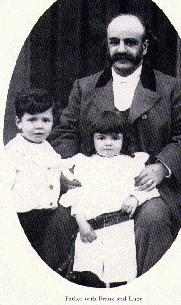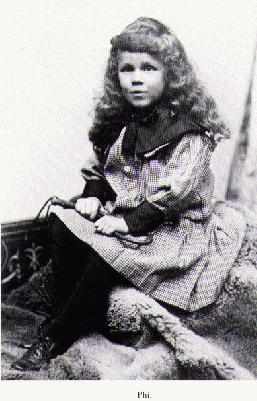
Figure 1.--Lucy, her brother Frank and their father in a photograph taken about 1895?. Notice Frank's short hair and boyish sailor suit


Figure 1.--Lucy, her brother Frank and their father in a photograph taken about 1895?. Notice Frank's short hair and boyish sailor suit |
Lucy M. Boston (her married name) published a fascinating autobiography describing her childhood and youth. The autobiography is Perverse and Foolish: A Memoir of Childhood and Youth (Atheneum, New York, 1979). It contains some intriguing photographs and interested incidents that she and her brothers
and sisters experienced in Edwardian turn-of-the-century England. The
book covers the period from the 1890s to the 1920s. There are also some interesting insights into nursery life.
The Wood children included six children, three boys and three
girls. They girls were Lucy, Frances, and Mary. The boys were Frank,
Jamie, and Phil. The only age I have on the exact ages of the children
is relative. They were all born approximately 1 year apart. The order
is Mary, Jamie, Frances, Frank, Lucy, and Phil. The ages of the
children, however, can be approximated. Notice in the group
photograph that all the girls are wearing black and all of the boys dark
clothes except for Phil. Lucy mentions in the book that her dad died
when she was six and that she wore black dresses until she was 12. So
Lucy in this photo is at least 6 or 7 years old. Since the
children are spaced approximately a year apart, the ages can be approximated at about 6-13 years.
Phil was the baby of the family and doted on by mother.
The two older boys wear suits with
knicker pants,
Eton collars, and short hair. Note the large
collar bows worn by the boys,
somewhat unusual for boys at that age wearing
Eton suits. The younger
boy, Phil, wears a skirted suit with a skirted outfit with front buttons
rather than knicker pants and has long hair that is naturally curly. Note that Phil is not much younger than Jamie.
That book doesn't have a single date in it. However, Lucy has studied in Paris before the start of World War I. So I would guess that the children were all born before 1896. That would place the photo at around the turn of the century. As I mentioned in my last e-mail, Lucy is probably at least 7 years old, and Phil a year younger at he time of the photo. The children, except Phil, are in mourning clothes in the photo and Lucy was 6 years old when her father
died.
The photographs suggest that much more care was taken with Phil's
outfits from than the other boys. In fact perhaps more care than for his sisters. Frank was, for example, dressed in much more
boyish outfits at a younger age and his hair cut short. I'm not sure why this was. I notice in many of the English accounts of boyhood memories, it was the older boy who often stayed in short pants longer than his younger brothers. Once long pants were bought
for one boy, the younger brothers often convinced their parents to also
buy long trousers for them. This does not seem to have occurred in the
Boston family. It may well be that there father's untimely death left
mother freer to make decissions on clothing.
Phil clearly wanted Eton suits like his brothers, but mother was
determined to dress her youngest son in more elaborate outfits and keep his
hair girlishly long. In fact, Phil appears to have longer hair than his
sisters.
One interesting aspect is that the Wood boys wear either very Boyish
Eton suits or girlish dresses. There does not seem to have beem any
intermediate step as was the case in many Edwardian families, such as
Fauntleroy suits and kilts. This demonstrates that there was not hard and
set rules concerning boys' clothes during the Edwardian period. A small
boy might have his hair cut and be dressed in a long pants
sailor suit
while an older boy might have long sasuage curls
and wear a skirted suit or
frilly lace collared Fauntleroy suit. It was all up to the mother's disgression and unlike today, the boy had little to say in the matter.
Phil was a year younger than Lucy. The author reports that when Phil was ready to go to school he was sent to the girls school with Lucy because his mother thought that his now waist length copper curls were just to beautiful to cut. I'm not sure what the uniform was at the school or how Phil was dressed. He stayed in the girls school with Lucy until he was 6 years old. Lucy said that he did not like the idea one little bit. She describes that

Figure 3.--The third photo is a closeup showing Phil in the same outfit as the group picture. |
Lucy describes her younger brother's perdicament in the book:
My youngest brother Phil had curly hair as fine as cobweb and the color of polished brass. It came down nearly to his waist and was considered too beautiful to cut off. The poor little Samson was sent at six with me to a private school of about forty girls. I could already read and write (at 7) but poor Phil screened and embarrassed by his trailing cloud of hair could master neither until he was ten (as soon as he went to school with his brothers).
The modern reader may find it stange that Phil was sent to a girls'
school as a young boy. It today's environment of large schools run by
corporations or charitable trusts, rules on attendance are much more set than was the case of 19th century schools. Private schools at the time were smaller and often owned and operated by the headmaster or headmistress. As a result, rules on attendance and administration were often at his or her disgression. A parents who sent three girls to a small school would undountedly be given serious consideration if they were to make such special requests. In addition, even today it is not uncommon for girls' schools to offer coeducational classes for the younger children.
The experience does not seem to have done Phil Wood any lasting
harm. After he entered the boy's school with his brothers, he was
known for his debating ability. Phil became a decorated Royal Air
Force pilot during World War I.
Navigate the Boys' Historical Clothing biographies pages:
[Main biographies page]
[Biographies A-F]
[Biographies G-L]
[Biographies M-R]
[Biographies S-Z]
Navigate the Boys' Historical Clothing Web Site:
[Return to Main English page]
[Introduction]
[Chronology]
[Clothing styles]
[Biographies]
[Bibliographies]
[Contributions]
[Countries]
[FAQs]
[Boys' Clothing Home]
